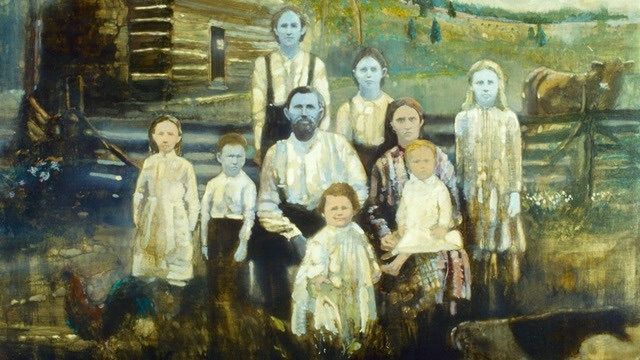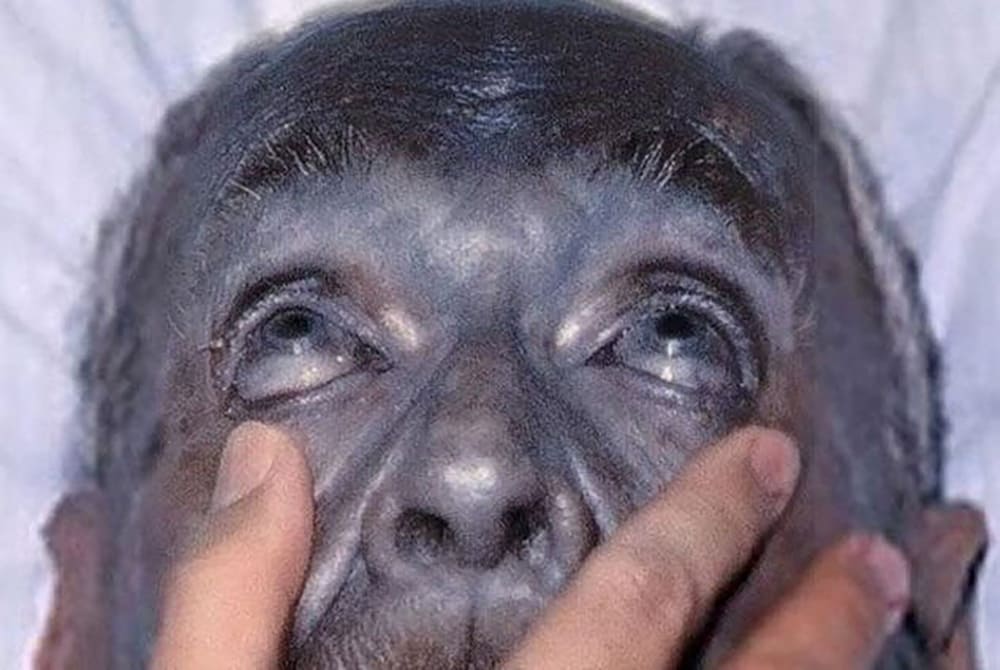In the heart of Appalachia, a remarkable tale unfolds, one that has intrigued scientists and historians alike for generations. The blue people of Kentucky, known as the Fugate family, have been the subject of fascination due to their unique blue skin, a physical trait that sets them apart from the rest of the world.
This extraordinary phenomenon is not a work of fiction or folklore, but a manifestation of a rare genetic condition known as methemoglobinemia.
This condition, passed down through generations of the Fugate lineage, has painted a vivid portrait of human genetics and the power of isolation in shaping our physical characteristics.
Join us as we delve into the captivating story of the Fugate family, exploring the science behind their distinctive blue skin and the legacy they have left behind.
Table of Contents
- 1. History of Fugate Family – Blue People of Kentucky
- 1.1 Arrival of Martin Fugate in Kentucky in 1820
- 1.2 Marriage to Elizabeth Smith and their Seven Children
- 1.3 The Seclusion of the Family
- 1.4 Continuation of the Blue Skin Trait
- 2. The Genetic Condition – Methemoglobinemia
- 2.1 What is Methemoglobinemia?
- 2.2 The Role of Hemoglobin and Methemoglobin in Blood
- 2.3 The Impact of a High Concentration of Methemoglobin on Skin Color
- 2.4 The Recessive Gene Causing Methemoglobinemia
- 3. Discovery of the Blue People of Kentucky
- 4. The Science Behind the Blue Skin
- 4.1 The Role of Genetics in the Manifestation of the Blue Skin
- 4.2 The Impact of Inbreeding and Isolation on the Prevalence of the Condition
- 4.3 The Health Implications of Methemoglobinemia
- 5. The Cure for Methemoglobinemia
- 5.1 The Discovery of the Cure by Dr. Madison Cawein
- 5.2 The Use of Methylene Blue Dye
- 5.3 The Transformation of the Blue Skin to Normal Color
- 6. Legacy of the Blue People of Kentucky
- 6.1 The Fading of the Blue Skin Trait
- 6.2 The Current Status of the Fugate Family Descendants
- 6.3 The Significance of the Blue People of Kentucky in Genetic Studies
- 7. Conclusion
- 8. FAQs
History of Fugate Family – Blue People of Kentucky
Arrival of Martin Fugate in Kentucky in 1820
The story of the blue people of Kentucky begins with the arrival of a French orphan named Martin Fugate in the year 1820.
Martin, who was said to have a peculiar blue tint to his skin, came to Kentucky to stake a claim and start a new life. He settled in Troublesome Creek, a remote area nestled in the hills of eastern Kentucky, far removed from the bustling cities and towns.
Marriage to Elizabeth Smith and their Seven Children
Martin Fugate married Elizabeth Smith, a fair-skinned, redheaded girl from the area. Unbeknownst to them, both Martin and Elizabeth carried a rare recessive gene that would have a profound impact on their lineage.
The couple had seven children, four of whom inherited their father’s distinctive blue skin. This marked the beginning of the blue-skinned Fugate family line.
The Seclusion of the Family
The Fugate family, embarrassed and ashamed of their unusual complexion, chose to live in isolation. Their home in the mountains of Kentucky, already remote due to the lack of roads and railroads, became their refuge.
The family rarely ventured into town, where they were often feared or mistreated by some of the townsfolk. Their unique skin color and isolated location led to a tight-knit community, largely cut off from the outside world.
Continuation of the Blue Skin Trait
The isolation of the Fugate family had another significant consequence – it led to intermarriage within the family.
Due to the lack of transportation and the geographical seclusion, the Fugates and their blue-skinned offspring had limited options for marriage outside their family.
This led to the continuation and proliferation of the blue skin trait within the family. The rare gene responsible for the blue skin found a perfect incubator in this isolated community, allowing it to thrive and be passed down through generations.
The Genetic Condition – Methemoglobinemia
What is Methemoglobinemia?
Methemoglobinemia is a rare genetic condition that affects the blood, not the skin pigment. It is characterized by an elevated level of methemoglobin, a form of hemoglobin, in the blood.
Contrary to common misconceptions, the blue skin of the Fugate family is not a result of a skin pigment disorder, but a direct consequence of this blood condition.
The Role of Hemoglobin and Methemoglobin in Blood
Hemoglobin is a vital protein in red blood cells responsible for transporting oxygen from the lungs to the body’s tissues and carrying carbon dioxide from the tissues back to the lungs.
Methemoglobin, on the other hand, is a form of hemoglobin that has been altered such that it is unable to effectively carry and release oxygen.
In healthy individuals, methemoglobin levels are typically less than 1% of total hemoglobin. However, in individuals with methemoglobinemia, these levels are significantly higher.
The Impact of a High Concentration of Methemoglobin on Skin Color
The blue skin color seen in the Fugate family is a result of the high concentration of methemoglobin in their blood. Methemoglobin has a dark blue color, and when its levels are elevated, it can give the skin a bluish or purplish hue.
This is because methemoglobin, unlike normal hemoglobin, doesn’t release oxygen effectively. As a result, the blood is less red and more blue, which shows through the skin and mucous membranes, giving them a blue color.
The Recessive Gene Causing Methemoglobinemia
Methemoglobinemia is caused by a recessive gene, which means that both parents must carry the gene for a child to be affected.
In the case of the Fugate family, the isolation and intermarriage within the family led to the gene being passed down through generations. This rare occurrence of both parents carrying the gene led to the unique blue skin trait seen in the family.
Discovery of the Blue People of Kentucky
The Birth of Benjamin Stacy in 1975
The story of the blue people of Kentucky gained mainstream attention with the birth of Benjamin “Benjy” Stacy in 1975. Unlike most newborns, Benjy was born with dark blue skin, a sight that alarmed doctors and nurses.
His unusual skin color prompted an extensive medical investigation. Despite numerous tests, the cause of his blue skin remained a mystery for two days.
The Connection to the Fugate Family
The mystery of Benjy’s blue skin was finally solved when his grandmother asked the doctors if they had heard of the Blue Fugates of Troublesome Creek, Kentucky.
This revelation led to the discovery that Benjy was a direct descendant of the Fugate family.
He was the great, great, great, great-grandson of Martin Fugate, the French orphan who brought the rare gene responsible for blue skin to Kentucky.
This connection to the Fugate family and the revelation of the blue skin condition brought the story of the blue people of Kentucky to light, providing a fascinating insight into the power of genetics and the impact of isolation on gene propagation.
The Science Behind the Blue Skin
The Role of Genetics in the Manifestation of the Blue Skin
The blue skin of the Fugate family is a clear demonstration of the power of genetics. The condition, methemoglobinemia, is caused by a recessive gene.
This means that both parents must carry the gene for a child to manifest the condition.
In the case of the Fugates, the gene was passed down through generations, leading to the prevalence of blue skin in the family. It’s a striking example of how a single gene can have a profound impact on our physical appearance.
The Impact of Inbreeding and Isolation on the Prevalence of the Condition
The isolation of the Fugate family and the subsequent intermarriage within the family played a significant role in the prevalence of the blue skin condition.
In a larger population, the chances of both parents carrying the same recessive gene are relatively low.
However, in a small, isolated community like the Fugates, these chances increase significantly. This led to the continuation and proliferation of the blue skin trait within the family.
The Health Implications of Methemoglobinemia
Methemoglobinemia, the condition responsible for the blue skin, is primarily a blood disorder. It affects the body’s ability to carry and release oxygen effectively.
However, despite the striking physical manifestation, the condition doesn’t seem to cause any special health problems.
Individuals with methemoglobinemia, including the Fugate family, can lead normal, healthy lives. The primary impact of the condition is the blue skin color, which can lead to social stigma and isolation.
The Cure for Methemoglobinemia
The Discovery of the Cure by Dr. Madison Cawein
The cure for methemoglobinemia was discovered by Dr. Madison Cawein, a hematologist at the University of Kentucky, in the 1960s.
Intrigued by the tales of the blue people of Kentucky, Dr. Cawein embarked on a mission to find a cure for this rare genetic condition. His research led him to the Fugate family and their unique genetic trait.
The Use of Methylene Blue Dye
Dr. Cawein’s breakthrough came when he discovered that methylene blue dye could convert methemoglobin back to hemoglobin.
Hemoglobin is the protein in red blood cells that carries oxygen, and its normal function is disrupted in people with methemoglobinemia.
By injecting the blue dye into the bloodstream, Dr. Cawein was able to restore the normal function of the red blood cells and effectively cure the condition.
The Transformation of the Blue Skin to Normal Color
The use of methylene blue dye had a dramatic effect on the Fugate family. Within minutes of receiving the treatment, their blue skin turned pink, marking the first time in their lives they had a normal skin color.
The transformation was not just physical but also psychological, as it helped the family overcome the social stigma associated with their blue skin.
As long as they continued the treatment, the blue people of Kentucky could live their lives with normal skin color, marking a significant milestone in the history of this unique family.
Legacy of the Blue People of Kentucky
The Fading of the Blue Skin Trait
Over time, the distinctive blue skin trait of the Fugate family began to fade. This was largely due to increased mobility and intermarriage outside the family.
As transportation improved and the Fugate family members began to move away from their isolated community, they married individuals who did not carry the methemoglobinemia gene.
This led to a dilution of the gene in the family lineage, resulting in fewer descendants manifesting the blue skin trait.
The Current Status of the Fugate Family Descendants
Today, most of the Fugate family descendants have lost their blue coloring. However, the tint still appears in their skin when they are cold or flush with anger.
The last known descendant born with the blue skin was Benjy Stacy, who lost most of his blue coloring by the age of seven.
Despite the fading of the blue skin, the legacy of the Fugate family lives on in their descendants and the history of Troublesome Creek.
The Significance of the Blue People of Kentucky in Genetic Studies
The story of the blue people of Kentucky holds significant value in the field of genetics. It provides a unique case study of how a rare genetic trait can proliferate in an isolated community.
The Fugate family’s history has contributed to our understanding of genetic disorders, recessive genes, and the impact of isolation and intermarriage on gene propagation.
Their story continues to be a subject of interest in genetic research, shedding light on the fascinating complexities of human genetics.
Conclusion
In conclusion, the story of the blue people of Kentucky, the Fugate family, is a remarkable tale of genetics, isolation, and the power of human adaptation.
Their unique history and genetic legacy serve as a testament to the fascinating complexities of human genetics and the impact of environmental factors on gene propagation.
It’s a stark reminder of the importance of understanding and accepting genetic diversity, as it shapes our identities and our understanding of the human condition.
As we reflect on their story, we are reminded that our differences, whether they manifest in our skin color or our genetic makeup, are what make us unique and contribute to the rich tapestry of human life.
If you found this article intriguing, please share it with others to spread awareness and appreciation for the incredible diversity of the human species.
FAQs
The Blue People of Kentucky were a family known as the Fugates who lived in the Appalachian Mountains of Kentucky. They were known for their distinctive blue skin, which was a result of a rare genetic condition called methemoglobinemia.
Methemoglobinemia is a rare genetic condition that affects the blood, not the skin pigment. It is characterized by an elevated level of methemoglobin, a form of hemoglobin, in the blood. High levels of methemoglobin can give the skin a bluish or purplish hue.
The Fugate family’s blue skin was a result of both parents carrying a recessive gene for methemoglobinemia. Due to their geographical isolation and intermarriage within the family, the gene was passed down through generations, leading to the prevalence of blue skin in the family.
Yes, a cure for methemoglobinemia was discovered by Dr. Madison Cawein in the 1960s. He found that methylene blue dye could convert methemoglobin back to hemoglobin, effectively curing the condition and transforming the blue skin to a normal color.
The story of the Blue People of Kentucky provides a unique case study for genetic research. It sheds light on the complexities of human genetics and the impact of isolation and intermarriage on gene propagation. Today, most of the Fugate family descendants have lost their blue coloring. But the legacy of the family lives on in their history and contribution to genetic studies.
Read More Interesting Stories:
- Full Story of Olivia Farnsworth: Bionic Girl Who Can’t Feel Pain, Hunger, Fatigue
- Tragic Story of Grayson Kole Smith – Boy With Rare Birth Defects, Syndrome Named After Him








